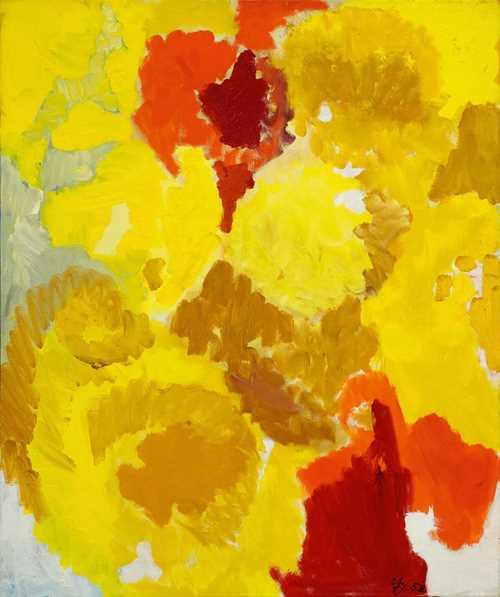
Lotto 3422* - A181 Postwar e contemporary art - sabato, 01. luglio 2017, 13h30
ERNST WILHELM NAY
- Galerie Günther Franke, Munich.
- Purchased from the above, since then collection Dr. Hans Werner Riedel and Dr. Ralf Dieter Loher-Riedel, Munich.
Exhibition: Munich 1958, E.W. Nay. Galerie Günther Franke, 16 August - 20 September (with illu.).
Literature: Scheibler, Aurel/Gohr, Siegfried: Ernst Wilhlem Nay. Werkverzeichnis der Ölgemälde. vol. II 1952-1968, Cologne 1990, no. 889.
Ernst Wilhelm Nay was born in Berlin in 1902, the second of six children. After finishing high school and having broken off his training in the book trade, he began an evening course in nude drawing in 1923. In the following year, as a self-taught artist, he applied for a place at the Academy of Fine Arts in Berlin under Carl Hofer, where he received a bursary one year later, and in 1928 graduated as Hofer’s master student. He soon took part in group exhibitions at important galleries such as Galerie Nierendorf in Berlin, Alfred Flechtheim in Düsseldorf and the Cassirer in Berlin. In addition, he was represented at various Sezessions exhibitions in Germany. Under the National Socialist dictatorship, Nay was classed as a “degenerate artist” and, although he was officially banned, he succeeded in obtaining painting materials and continued to paint. In 1940, he was conscripted into military service and sent to France. Shortly after the end of the Second World War, Nay began to exhibit again, and his works were purchased by well-known museums. Galerie Franke in Munich, where the present work was exhibited, was his regular gallery. He took part in three Documentas in Kassel between 1955 and 1964, and was awarded various art prizes such as Ströher prize and the Lichtwark prize. Ernst Wilhelm Nay died in 1968.
In the 1950s Nay was the leading artist of his generation. As with hardly any other artist, his work can be divided chronologically and thematically into clearly defined phases, of which the “Scheibenbilder” (Disk pictures) from 1954 to 1963 represent the largest and most important group. All the phases build on one another and refer to one another. Ernst Wilhelm Nay had a very clear vision of his artistic creativity and, despite their apparent haphazardness, his works are underpinned by a strict order, in which three aspects are decisive. Firstly, the work is about the picture itself and not about possible interpretations or motifs. Secondly, the artist decides the form and the colour - but even here there is no motif. Thirdly, the artist’s intuition and inspiration are part of the process of creating the work.
The present work from 1958 is one of the “Disk pictures”, which, through the artist’s inspiration, impressively demonstrate his will to create form. Colour and form are subject to an order, which Nay masterfully employs to produce tension and dynamism, “The layering of the whole, half, or irregular disk forms preclude any innocuous balance. Even in the brilliant, alluring and beautifully arranged ‘disk pictures’ Nay preserves the energy of friction, of contrast, of opposition, which determine the conditions and elixir of his invention. This is not decoration, but the underlying tension within a colour circle which drives the inspiration.” (quote from: Siegfried Gohr, in: Scheibler, Aurel/Gohr, Siegfried: Ernst Wilhlem Nay. Werkverzeichnis der Ölgemälde. Vol. II 1952-1968, Cologne 1990, p. 22)
In 1958 Nay developed the “disk pictures” yet further, and “Mit vielfältigem Gelb” is an outstanding example of this. The individual disks are reduced into one composition. They are less severe, but can be ragged around the edges. In addition, the brush style has acquired a greater importance. Gohr describes it as follows: “Blossoming brush strokes, flecks of impasto, ductile, coated surfaces, hatching, etc. which, alongside the activity of the colour, give the body of the picture a new dimension (…).” (ibid. p. 23)
CHF 120 000 / 180 000 | (€ 123 710 / 185 570)
Venduto per CHF 186 500 (incl. premio dell'acquirente)
Non si assume alcuna responsabilità per la correttezza di queste informazioni.

